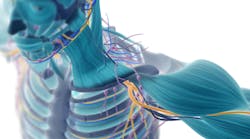Take a stand! The ergonomic benefits of standing hygiene
When you were a kid, did you ever get scolded for tipping forward in your chair, or worse, tipping backward and teetering on the two hind legs? You didn’t think about your posture or biomechanics. You were forced to sit in hard wooden chairs, and you squirmed and fidgeted because your body wasn’t happy.
To counteract this frustration, you moved around to find freedom; your body knew it needed to be in a neutral spine, opening the front of the hip joint while leaning backward on the chair, and lengthening the back spine while hinging forward on the two front chair legs.
Clinically, sitting for long periods of time while leaning forward and performing repetitive motions (i.e., scaling) builds the front of the body, making these muscles dense and tight, while the opposing back muscles overstretch, making them long and weak. A slumped spine and upper body impair breathing by shortening and compressing the chest, lungs, and diaphragm.
We live in a seated society. But here’s the question: why do you sit for clinical hygiene? Take a moment and think about it; why do you sit? Is it because someone told you to? Is it because others do it? Maybe you never gave it a thought. Now is the time to consider taking a stand! Literally.
Why should you consider standing hygiene?
Standing has two important and favorable qualities. First, when you sit, the intervertebral disc pressure is twice as high when compared to standing. This is because the vulnerable lumbar region loses its protective natural curve. Second, when you move from standing to sitting, the pelvis rotates backward posteriorly, flattening the lower lumbar spine by at least 30 degrees.
Standing takes more muscular energy; however, standing can also reduce blood supply to loaded muscles (not such a good thing if you have weak leg veins). To combat this potential problem, keep moving! Try to sit for the maxilla and stand for the mandible. Consider root planing for 45 minutes while standing, then sit for the next patient. Vary your movements and avoid extreme bending, stretching, and twisting, just as you would if you were seated.
Standing while working often provides an opportunity to employ direct vision, thus preventing unnecessary leaning and twisting. In addition, the use of extraoral fulcrums, which provide added stability and leverage, can sometimes be used.
It’s imperative while standing that your neck and spine are not compromised. Do not lean over the patient to get a better view. This can strain the neck and upper back muscles. In addition, your shoulders should be in alignment with your body and the forearms should be parallel with the floor, allowing the elbows to rest close to your body for support.
Working distance should also be considered
Even while seated, it’s common for an operator—who has the innate desire to perform the best work possible—to lean forward involuntarily, bringing the eyes closer to the viewing area to gain visual acuity. Loupes provide a longer working distance, thus preventing the practitioner from leaning forward and getting into awkward postures.
Whether standing or sitting, the operator’s working distance should be the same when the patient is positioned correctly. Loupes help greatly in maintaining this proper posture. Well-fitted dental loupes should have a working distance long enough so the operator can stand or sit with their shoulders and neck in a healthy, neutral position.
Dental loupes should also have a steep optical declination to allow the eyes to look downward without bending the neck forward. Otherwise, this precarious and compromised neck position takes the approximately 13-pound unsupported weight of the head forward, leading to muscle strain.
Imagine a bowling ball size black pearl necklace hanging like a dead weight off the center of your shoulders. Then, hold it there for eight hours! This is what happens when you crane your neck anteriorly over the sternum/centerline of your body. Keep your neck aligned and neutral as much as possible.
While standing, bring the chair base all the way up. While performing procedures on the mandible, bring the headrest and backrest up so the patient’s chin is as parallel to the floor as possible. If you’re taller than average and your chair doesn’t go up high enough to counter this effect, standing may not be for you. The patient’s size may also make a difference. Be mindful of both situations.
Are you still not ready to stand? Consider that advocates of standing point to studies showing that after a meal, those who stand burn more calories compared to those who sit, and their sugar levels return to normal faster. Finally, standing may lower the risk of shoulder, neck, and back pain because the pressure and stress on those muscles and joints is reduced, helping you maintain good posture.
So, what are you waiting for? Go ahead and take a stand!
About the Author

Juli Kagan, MEd, RDH
Juli Kagan, MEd, RDH, believes the mind-body connection is vital for mental, physical, and spiritual well-being. Author of the book Mind Your Body, she’s passionate about intelligent movement and has a unique understanding of biomechanics and ergonomics, and an expertise in posture. She’s a previous dental (and hygiene) school clinical instructor and lecturer, as well as a Pilates instructor and Iyengar credential experienced registered yoga teacher. Juli has a master’s degree in educational psychology.


